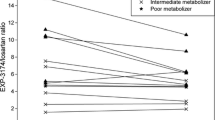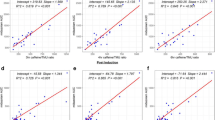Abstract
Objectives: Claims that substituted benzimidazole molecules induce cytochromes P4501A2 are still controversial. This study was undertaken to evaluate their inducing potency under conventional therapeutic conditions.
Methods: Twelve healthy non-smoking young volunteers were given 20 mg omeprazole or 30 mg lansoprazole daily, in random order, for 2 weeks, separated by a 3 week wash-out period. We evaluated the CYP1A2 activity by the ratio of the molar urinary concentrations (CUM ratio) of the three end products of the paraxanthine demethylation of caffeine over the molar concentration of a paraxanthine 8-hydroxylation product.
Results: This urinary metabolite ratio has previously been shown to be correlated with caffeine clearance. There was slight but non-significant enhancement of the CUM ratio after 2 weeks of treatment with omeprazole (3.62 (1.58) on Day 15 vs 3.09 (1.43) on Day 1), and after lansoprazole (4.26 (2.3) vs 3.65 (2.36)). Similarly, one week of treatment did not significantly alter the CUM ratio after omeprazole or lansoprazole (3.11 (1.58) and 3.28 (1.59), respectively on Day 8).
Conclusion: The results show that both omeprazole and lansoprazole in the daily recommended therapeutic doses of 20 mg and 30 mg, respectively, have no influence on the metabolism of caffeine, and therefore no influence on cytochrome CYP1A2 activity.
Similar content being viewed by others
References
Nelson DR, Kamataki T, Waxman DJ, Guengerich FP, Estabrook RW, Feyereisen R, Gonzalez FJ, Coon MJ, Gunsamus IC, Gotoh O, Okuda K, Nebert DW (1993) The P450 superfamily: update on new sequences, gene mapping, accession numbers, early trivial names of enzymes, and nomenclature. D N A Cell Biol 12:1–51
Sesardic D, Boobis AR, Murray BP, Murray S, Segura J, DeLa Torre R, Davies DS (1990) Furafylline is a potent and selective inhibitor of cytochrome P4501A2 in man. Br J Clin Pharmacol 29:651–663
Farrell GC, Murray M (1990) Human cytochrome P450 isoforms. Gastroenterology 99:885–889
Parkinson A, Hurwitz A (1991) Omeprazole and the induction of Human Cytochrome P-450. A response to concerns about potentiel adverse effects. Gastroenterology 100:1157–1164
Wallmark B, Lorentzon P, Larsson H (1985) The mechanism of action of omeprazole — a survey of its inhibitory actions in vitro. Scand J Gastroenterol 20 [Suppl 108]:37–51
Regardh CG, Gabrielsson M, Hoffman KJ, Löfberg I, Skanberg I (1985) Pharmacokinetics and metabolism of omeprazole in animals and man. An overview. Scand J Gastroenterol 20 [Suppl 108]:79–94
Diaz D, Fabre I, Daujat M, Saint Aubert B, Bories P, Michel H, Maurel P (1990) Omeprazole is an aryl hydrocarbon-like inducer of human hepatic cytochrome P-450. Gastroenterology 99:737–747
Anderson T, Bergstrand R, Cederberg C, Eriksson S, Lagerström PO, Skanberg I (1991) Omeprazole treatment does not affect the metabolism of caffeine. Gastroenterology 101:943–947
Campbell ME, Spielberg SP, Kalow W (1987) A urinary metabolite ratio that reflects systemic caffeine clearance. Clin Pharmacol Ther 42:157–165
Butler MA, Iwasaki M, Guengerich FP, Kadlubar FF (1989) Human cytochrome P-450PA (P-4501A2), the phenacetin-O-deethylase, is primarily responsible for the hepatic 3-demethylation of caffeine and N-oxidation of carcinogenic arylamines. Proc Natl Acad Sci USA 86:7696–7700
Kalow W, Tang BK (1993) The use of caffeine for enzyme assays: a critical appraisal. Clin Pharmacol Ther 53:503–514
Vistisen K, Loft S, Poulsen HE (1990) Cytochrome P4501A2 activity in man measured by caffeine metabolism: effect of smoking, broccoli and exercise. Adv Exp Med Biol 283:407–411
Conney AH, Pantuck EJ, Hsiao KC, Garland WA, Anderson KE, Alvares AP, Kappas A (1976) Enhanced phenacetin metabolism in human subjects fed charcoal-broiled beef. Clin Pharmacol Ther 20:633–642
Catteau A, Bechtel YC, Poisson N, Bechtel PR, Bonaïti-Pellie C (1995) A population and family study of CYP1A2 using caffeine urinary metabolites. Eur J Clin Pharmacol 47:423–430
Grant DM, Tang BK, Kalow W (1983) Variability in caffeine metabolism. Clin Pharmacol Ther 33:591–602
Machin D, Campbell MJ, (1987) Statistical table for the design of clinical trials. Blackwell, Oxford, 47–48
Rost KL, Roots I (1994) Accelerated caffeine metabolism after omeprazole treatment is indicated by urinary metabolite ratios: coincidence with plasma clearance and breath test. Clin Pharmacol Ther 55:402–411
Campbell ME, Grant DM, Inaba T, Kalow W (1987) Biotransformation of caffeine, paraxanthine, theophylline, and theobromine by polycyclic aromatic hydrocarbon-inducible cytochrome(s) P450 in human liver microsomes. Drug Metab Dispo 15:237–249
Kalow W, Tang BK (1991) Caffeine as a metabolic probe: exploration of the enzyme-inducing effect of cigarette smoking. Clin Pharmacol Ther 49:44–48
Bologa M, Tang B, Klein J, Tesoro A, Koren G (1991) Pregnancy-induced changes in drug metabolism in epileptic women. J Pharmacol Exp Ther 257:735–740
Shaw-Stiffel TA, Tang BK, Spielberg SP, Shear NH (1988) Caffeine — a novel probe to assess drug effects on hepatic cytochrome P-450 activity [Abstract]. Hepatology 8:1385
Robson RA, Miners JO, Matthews AP, Stupans I, Meller D, McManus ME, Birkett DJ (1988) Characterization of theophylline metabolism by human liver microsomes. Biochem Pharmacol 37:1651–1659
Taburet AM, Geneve J, Bocquentin M, Simoneau G, Caulin C, Singlas E (1992) Theophylline steady state pharmacokinetics is not altered by omeprazole. Eur J Clin Pharmacol 42:343–345
Gugler R, Jensen JC (1987) Drugs other than H2-receptor antagonists as clinically important inhibitors of drugs metabolism in vivo. Pharmacol Ther 33:133–137
Oosterhuis B, Jonkman J, Anderson T, Zuiderwijk P (1992) No influence of single intravenous doses of omeprazole on theophylline elimination kinetics. J Clin Pharmacol 32:470–475
Nousbaum JB, Berthou F, Carlhant D, Riche C, Robasziekiewicz M, Gouerou H (1994) Four-week treatment with omeprazole increases the metabolism of caffeine. Am J Gastroenterol 89:371–375
Rost KL, Brösicke H, Heinmeyer G, Roots I (1994) Specific and dose-dependent enzyme induction by omeprazole in human beings. Hepatology 20:1204–1212
Author information
Authors and Affiliations
Rights and permissions
About this article
Cite this article
Rizzo, N., Scherrmann, J.M., Padoin, C. et al. Omeprazole and lansoprazole are not inducers of cytochrome P4501A2 under conventional therapeutic conditions. Eur J Clin Pharmacol 49, 491–495 (1996). https://doi.org/10.1007/BF00195936
Received:
Accepted:
Issue Date:
DOI: https://doi.org/10.1007/BF00195936




